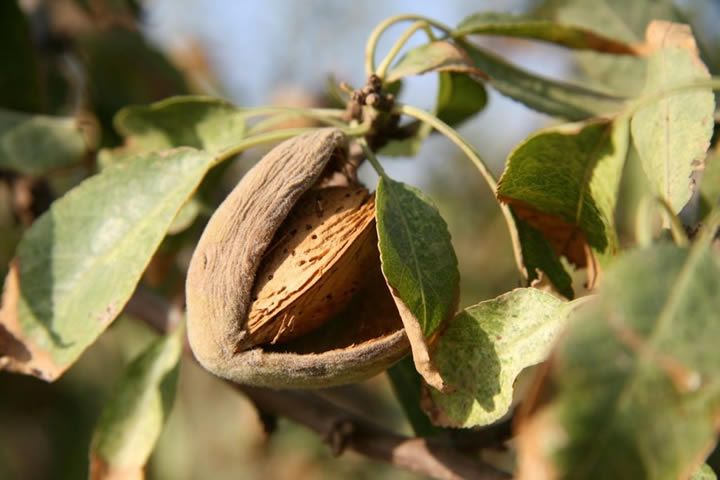One of the most persistent threats to almond production is the presence of insect pests. These unwelcome visitors can cause significant damage, reducing yields and impacting the quality of the almonds.
 Guarding Your Grove: Understanding Almond Pest Monitoring
Guarding Your Grove: Understanding Almond Pest Monitoring

Grady Moore | Farmsense
The almond industry is a cornerstone of American agriculture, with California’s Great Central Valley being responsible for producing 82% of the world’s almond supply across 1.5 million acres. This agricultural sector not only fuels local economies but also helps meet the growing global demand for healthy, plant-based foods. However, the journey from blossom to nut is filled with challenges for almond farmers, who must navigate a litany of environmental obstacles to maintain their crops. That’s why we’ve decided to discuss the significance of commercial almond pest monitoring in this month’s article.
One of the most persistent threats to almond production is the presence of insect pests. These unwelcome visitors can cause significant damage, reducing yields and impacting the quality of the almonds. Key culprits include the navel orange worm, carpophilus beetle [nitidulid sap beetles/dried fruit beetles], spider mites, and aphids, each bringing unique threats that require vigilant management. The navel orange worm, for instance, bores into the nuts, leaving behind waste and potentially harmful toxins that can make the product unsuitable for consumption. Sap beetles, spider mites, and aphids, on the other hand, weaken the trees by feeding on their leaves’ phloem and xylem tissues [sap, juices, vascular system], leading to reduced vigor, ability to photosynthesize, and an increased susceptibility to other stressors.
Given these challenges, effective and timely pest monitoring is indispensable for almond farmers. By closely tracking pest populations and behaviors, growers can make informed decisions about when and how to intervene. This proactive approach helps to minimize crop losses and reduces the need for broad-spectrum pesticides, which can be harmful to beneficial insects and the environment. Real-time monitoring technology, such as FarmSense’s FlightSensor, is revolutionizing the way farmers protect their orchards, making almond pest monitoring more precise, timely, and sustainable.
In essence, the success of the almond industry hinges not only on favorable growing conditions but also on the ability of farmers to anticipate and address the threats posed by insect pests. Through diligent monitoring and innovative solutions, almond farmers can continue to thrive and contribute to a robust agricultural economy.
Challenges Faced by Almond Farmers
Almond farming can be a rewarding industry, but it comes with a unique set of challenges that farmers must expertly navigate to ensure healthy, productive, and profitable orchards. Among these challenges, pest monitoring and control stands out as a critical component of successful almond cultivation. Effective almond pest management requires continuous observation which has become much more feasible in recent years thanks to real-time, autonomous almond pest monitoring technology. Farmers who have adopted this type of almond pest monitoring technology are able to better protect their crops while minimizing the reliance on pesticides, which can have broader environmental impacts.
Another notable hurdle for almond farmers is the management of mummy nuts. Mummy nuts are the name given to almonds that remain on the trees after harvest and become a breeding ground for pests, particularly the navel orangeworm. IPM Innovator Award winner and licensed pest control advisor, Cliff Kitayama, Ph.D., discussed this issue with us recently, “shriveled mummy nuts are usually caused by water stress or sometimes by a broken branch that creates a similar condition. These are typically referred to as “stick tights” and are extremely difficult to remove. Stick tights often maintain a tight seal and are not as easily accessible to insects.” Kitayama went on to explain, “pests like the navel orange worm (NOW) and the nitidulid sap beetle [commonly referred to as the carpophilus beetle or dried fruit beetle], tend to target mummy nuts that have a poor seal and good kernel as these create the best over-wintering environment.” Almond farmers must implement meticulous orchard sanitation practices to address mummy nuts, such as shaking and sweeping the trees post-harvest to remove these remnants. These practices, although a time and labor-intensive one, not only helps reduce pest populations but also promotes healthier trees and better yields in subsequent seasons.
Water management is another aspect that almond farmers must master. With the increasing frequency of droughts and the growing competition for water resources, efficient irrigation practices are essential. Farmers are adopting irrigation technologies, such as drip and micro-sprinkler systems, which deliver water directly to the root zone, reducing waste and optimizing water use. These systems, combined with precise soil moisture monitoring, help ensure that trees receive the right amount of water at the right time. Fortunately, efforts to reduce water requirements for almond farmers have been significantly reduced over the years. The Almond Board of California reports that growing one pound of almonds requires 33% less water compared to 20 years ago.
Soil health also plays a pivotal role in the productivity of almond orchards. Healthy soil supports robust root systems, enhances nutrient uptake, and improves water retention. Almond growers are increasingly turning to sustainable practices like cover cropping, compost application, reduced tillage to maintain and improve soil quality in addition to practices like providing habitats for beneficial insects like honey bees and other pollinators. These practices not only foster a more resilient farming system but also contribute to the long-term sustainability of the orchard.
Almond farmers face a complex array of challenges that require a multifaceted approach to overcome. From pest monitoring and control to managing mummy nuts, optimizing water use, and maintaining soil health, each element is critical to the success of the orchard. By adopting innovative techniques and sustainable practices, almond farmers can continue to thrive and meet the demands of a growing market.
Common Insect Pests in Commercial Almond Farming
Insect pests present one of the most significant challenges for almond farmers, impacting both yield and quality of the nuts. These pests can cause substantial economic losses, as they damage the crops directly and make them more susceptible to other issues. Effective almond pest monitoring is crucial to mitigate these losses and ensure healthy almond production. Although the variety of insect pests that almond farmers must monitor for is vast, there are two specific insects that typically cause the most headaches for almond growers:
Navel Orange Worm (NOW)
The navel orange worm (Amyelois transitella) is one of the most destructive pests in almond orchards. This pest’s lifecycle begins with eggs laid on almond hulls, followed by larvae burrowing into the nuts to feed. This behavior not only damages the nuts but also leaves them contaminated with waste and toxins that leads to the growth of fungal contaminants. Infestations can lead to severe economic impacts, as damaged almonds are often unmarketable. The costs associated with controlling NOW, including the implementation of traps and insecticides, add to the financial burden on farmers. Recent reports revealed that NOW infestations cost almond farmers an average of $393/acre for winter sanitation and pesticides — an estimated revenue loss of 8%. Thankfully, advances in almond pest monitoring technology has given farmers the capabilities of real-time detection for the presence of the adult female moths responsible for laying NOW eggs on almond hulls. Timely notifications of pest pressure in almond orchards arms farmers with actionable insight, allowing them to begin mitigation procedures before infestations get out of hand.
Carpophilus Beetle [Dried Fruit Beetle/Nitidulid Sap Beetle]
The Carpophilus beetle — sometimes referred to as the dried fruit beetle or nitidulid sap beetle — is an invasive species that has recently been found infesting almonds and pistachios in California’s Central Valley, is another significant pest in almond farming. This beetle has a life cycle that includes overwintering in mummy nuts, which are nuts left on the trees post-harvest. These beetles emerge in the spring to feed on the new crop, causing direct damage to the almonds. The presence of carpophilus beetles can lead to reduced almond quality and yield, necessitating increased pest management efforts to protect the crop.
The Value of Real-Time Almond Pest Monitoring Technology
True for all farmers, but especially for almond farmers, staying ahead of pest infestations is crucial. Timely and accurate almond pest monitoring allows farmers to detect issues early, making it easier to manage and control potential outbreaks. Real-time monitoring technology like FarmSense’s award-winning FlightSensor, provides the necessary data to make informed decisions, ensuring that interventions are both effective and efficient. The benefits of replacing antiquated detection methods like sticky traps with real-time almond pest monitoring technology make the decision a no-brainer for most almond farmers. Benefits of autonomous almond pest monitoring systems include:
Improved Pest Management
Real-time almond pest monitoring enhances the ability of farmers to track insect pest populations and behaviors continuously. This constant flow of information enables more precise targeting of pest control measures, ensuring they are applied when and where they are most needed. As a result, the overall effectiveness of pest management strategies is significantly improved.
Reduced Reliance on Chemical Pesticides
With accurate data on almond pest activity, farmers can adopt a more targeted approach to pest control, reducing the need for broad-spectrum chemical pesticides. This precision not only minimizes the environmental impact but also helps protect beneficial insects that are crucial for the health of the ecosystem.
Cost Savings and Increased Yields
Effective almond pest monitoring can lead to substantial cost savings for almond farmers. By catching infestations early, farmers can avoid the extensive damage that can lead to significant financial losses. Additionally, healthier crops mean higher yields, which directly contributes to increased profitability.
Improved Sustainability
Adopting real-time almond pest monitoring technology also supports the broader goal of sustainable farming and integrated pest management (IPM) practices — or the evolved, “sustainable pest management” (SPM), as defined by the California Department of Pesticide Regulation. By reducing the reliance on broad-spectrum pesticides and instead, focusing on targeted interventions, almond farmers can maintain healthier orchards and promote environmental stewardship. This approach not only benefits the current crop but also helps to ensure the long-term viability of almond farming operations.
The Takeaway – Almond Pest Monitoring
Almond pest monitoring is one of the essential elements in ensuring the sustainability of almond farming. By integrating advanced almond pest monitoring tech, farmers can more effectively manage pest populations, reduce the reliance on chemical pesticides, and enhance both yield and crop quality. Additionally, this type of pest monitoring technology also reduces the labor intensive task of driving to each trap to inspect and count insects on a regular basis. Looking ahead, the future of pest management in almond farming promises further innovations, from improved real-time data analytics to the integration of ecological practices that bolster the resilience of orchards. These advancements will not only benefit individual farmers but also contribute to a more sustainable and prosperous agricultural community. As we embrace these new tools and techniques, we can look forward to a thriving almond industry that supports both our environment and our economy, creating a promising and prosperous future for all involved.
About Grady Moore
Grady Moore is a writer and business consultant for the ag-tech, cannabis, and hemp industries. He holds a Master of Science in medical cannabis science and therapeutics from the University of Maryland. When he isn’t working, you can likely find him playing with his golden retriever named Doobie, taking time-lapse photography, or practicing cello. To keep up with Grady, follow him on LinkedIn.
The content & opinions in this article are the author’s and do not necessarily represent the views of AgriTechTomorrow
Comments (0)
This post does not have any comments. Be the first to leave a comment below.
Featured Product

